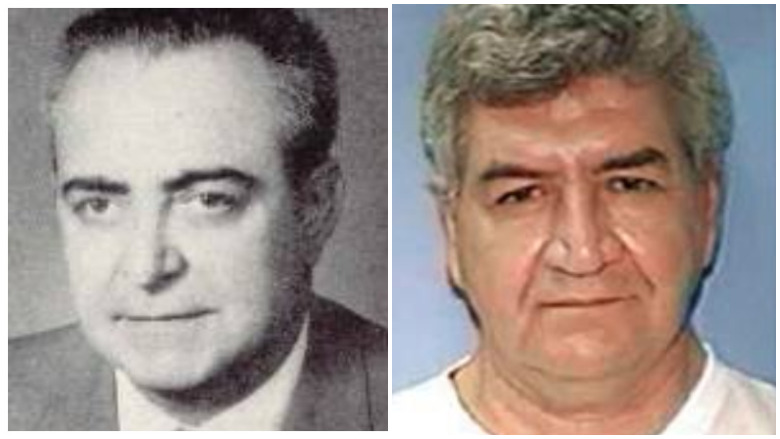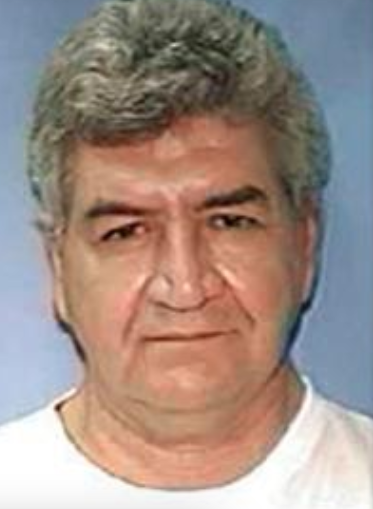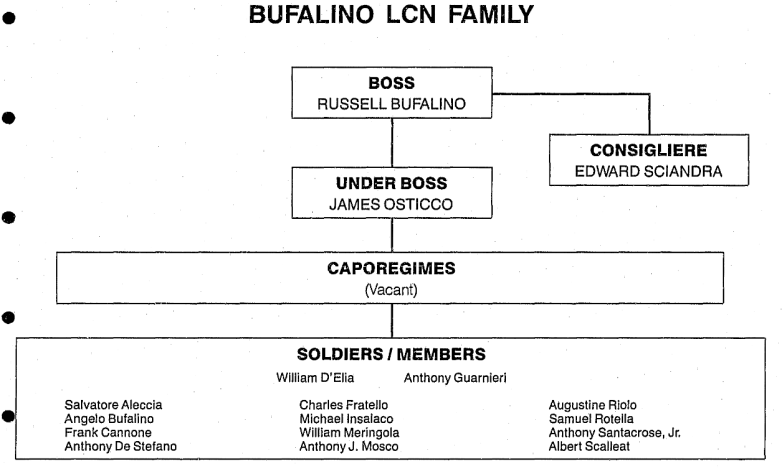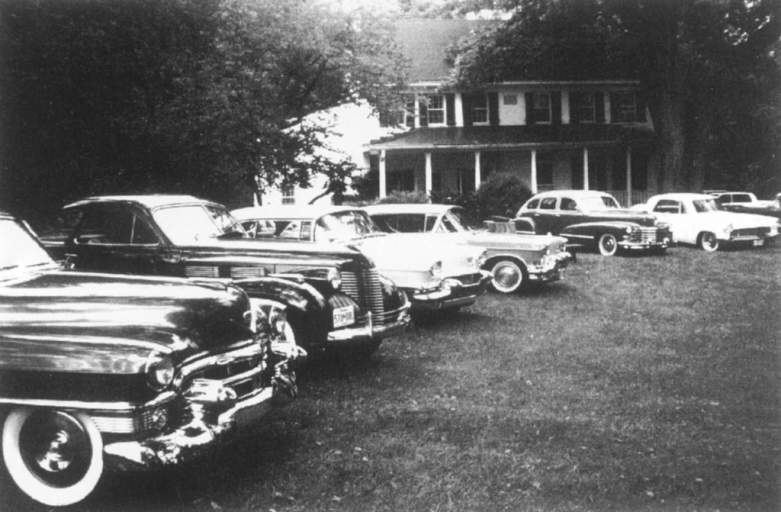
Wikimedia Commons/Mugshot Russell Bufalino of the Bufalino Crime Family and William D'Elia.
There was a time when the Bufalino Crime Family had a rock-solid grip on the Pennsylvania area, running a number of rackets for the Mafia. So influential was this crime family out of Pittston that it was considered one of the top Mafia families in the country. Some believe its Mafia chief, the powerful and secretive Russell Bufalino, called for the hit against Teamster boss Jimmy Hoffa.
The Bufalino Crime Family and the theories linking it to Hoffa’s death feature prominently in the new Netflix mob movie by Martin Scorsese, The Irishman.
The Irishman in the movie and in real life was a man named Frank Sheeran who, newspaper articles from the 1960s, 1970s and 1980s show, openly admitted associating with Russell Bufalino, the crafty Bufalino Crime Family boss who sat at the top of the Family’s hierarchical chart for decades. The Family was primarily based in Scranton, Wilkes-Barre, and Pittston, Pennsylvania.
Known as “McGee” and the “Old Man,” Russell’s garment businesses served as the front. He was a Sicilian immigrant. Sheeran told author Charles Brandt in 2004 that Bufalino ordered the assassination of the powerful labor leader, Hoffa, who disappeared in Detroit in 1975 and was simply never seen again. Russell Bufalino (played by Joe Pesci in The Irishman) was born as Rosario Alberto Bufalino. He was the leader of the Family for decades.
Citizens Voice, which obtained Bufalino’s FBI file, described him as the “soft-spoken, eight-fingered Sicilian with a lazy eye, known to his closest associates as ‘McGee.'” You can read the more than 1,000-page FBI file obtained by Citizens Voice on Bufalino here.
One FBI report in that file indicated that “Sheeran was observed driving Russell Bufalino in Detroit right after Jimmy Hoffa’s disappearance,” Citizens Voice reported.
A 2016 article in Penn Live reported that the Bufalino crime family “is one of three prominent La Cosa Nostra families in Pennsylvania,” but its power has waned. Today, it no longer exists as it once did, although the Family made the news with prosecutions of a purported boss as late as 2010. Its power started to wane in the 1980s, however, as the government went after crime family leaders. Although Bobby Kennedy lost his Attorney General’s perch when his brother was assassinated and then he was murdered himself, his prosecutorial approach against the mob outlived him and saw new life in RICO prosecutions.
The Brandt book, I Heard You Paint Houses (a reference to mob assassinations), quotes Sheeran as calling Russell Bufalino “the other one of the two greatest men I ever met.” His favorite song was “Spanish Eyes.” The famous Five Families of New York sought his counsel. The book says Bufalino didn’t want Jimmy Hoffa to run for union president again. Both were short men who were “solid muscle from head to toe.” They had an alliance and mutual respect that disintegrated after Bobby Kennedy’s war against the mob and Hoffa’s subsequent attempt to regain control of the Teamsters. The mob thought Hoffa was a rat and their share of the pension system was in peril. Bufalino, Sheeran says, decided that Jimmy Hoffa had to go and asked him, a friend, to carry out the hit because Hoffa would be unsuspecting.
The book says that Time Magazine reported at the time that Bufalino and Chicago mob boss Sam Giancana “had worked on behalf of the CIA in 1961 in the Bay of Pigs invasion of Cuba and in 1962 in a plot to kill Castro.”
Russ was “very spry,” and born in Sicily but “spoke perfect English.” He was married to wife Carrie but they didn’t have children, the Brandt book says. Russell said of Jimmy, according to Sheeran in the book: “Your friend made one threat too many in his life… there won’t be a body. My Irishman, we did all we could for the man. Nobody could tell that man what it is. We get into Detroit together Wednesday night.” At the time, Hoffa was “as famous as Elvis.”
Bufalino’s wife, Carolina Sciandra, Carrie, was “related to the Sciandra line of La Cosa Nostra.” Her family didn’t have bosses in it but went back “to the earliest days of the American Mafia.” Sheeran said that, of all of the crime bosses he met, Russell’s “mannerisms and style” most fit those depicted by Marlon Brando in The Godfather. Yet his name was not widely known to the public, and he liked it that way.
Here’s what you need to know about the Bufalino Crime Family:
The Bufalino Crime Family Existed Through at Least 2010 But Lost A Great Deal of Power Over Time, Reports Say

William D’Elia
As late as 2010, the Morning Call was reporting on the crime family. The newspaper identified William D’Elia as then “the reputed head of the Bufalino crime family,” and said he was being held in a federal prison in Arizona, where he was serving a 9-year sentence meted out in 2008 for money laundering and witness tampering conspiracy charges.
The “Scranton crime boss” was brought down by a mob informant later said to have committed suicide, Morning Call reported in 2012.
D’Elia was Russell Bufalino’s successor, according to Citizens Voice, adding that Bufalino suffered a stroke in prison and died in 1994 in a nursing home. The site reports that two Pennsylania judges went down with D’Elia, accused of kickbacks.
James Kanavy, a former investigator for the Pennsylvania Crime Commission, told Citizens Voice in 2011 that he doesn’t think the Bufalino Crime Family really exists anymore, though.
“I don’t think there’s a standalone family here any more,” Kanavy said to the site. “Any remnants here would be aligned with the New York families.” He attributed the downfall to “the decline” in coal and garment industries, which sucked up the mob’s profits, and the federal government’s use of the RICO statute to bust up crime families.
In the Netflix movie, a gold ring plays a prominent role. Made of three-dollar liberty coins from the 1880s, Russell Bufalino tells Sheeran in the movie that only three exist in the world, and that the ring symbolizes the fact that Sheeran has moved into Bufalino’s inner sanctum. Sheeran wrote in the Brandt book that Bufalino did give him one of the three rings. Russell had the second and his underboss the third.
In the movie, Bufalino has a ring and Angelo Bruno, another crime boss, has a third. That’s a deviation from real life. Angelo Bruno, in real life, wasn’t Bufalino’s underboss. Bruno was the boss of the Philadelphia mob family.
So who had the third ring?
In the book, the author says that Big Bill D’Elia was an underboss who became godfather of the Bufalino family when Russell died. In 2006, he was indicted for money laundering. He was Russell’s nephew and daily companion.
In 1972, Russell “made up three diamond-encrusted three-dollar gold-coin rings for himself, for Frank, and for a third person whose identity I’d left out of the book. These rings signified an inner circle of three,” wrote Russell, but he added an update to his book identifying the third person.
Billy had the third ring, Brandt wrote.
Russell Bufalino Ran the Once ‘Powerful Cosa Nostra Family’ That the Government Warned ‘Should Not be Underestimated’

Pennsylvania Crime Commission report in 1989 on the Bufalino Crime Family.
The details of the Bufalino Crime Family’s organization and rackets were outlined in a Pennsylvania Crime Commission 1989 report. It quoted an earlier 1980 report that stated that the Russell Bufalino Family was described as operating “in northeastern Pennsylvania, New York State and New York City” and “may be the most powerful Cosa Nostra Family in the Commonwealth…the power which is held by Bufalino and his Family should not be underestimated.” By 1989, the power of the Family had weakened substantially already, though, because Russell was aging and hesitant to swing open the doors to new blood.
The Family had been in Pennsylvania for a century, dating back to the 1880s, when Bufalinos moved from Sicily, Italy to the Pittston area of Luzerne County. Russell was born Rosario Albert Bufalino on October 29, 1903 in Sicily, the report says. He became the boss of the northeastern Pennsylvania Cosa Nostra Family in 1959, one of the nation’s “most ruthless and powerful organized crime figures,” according to the Commission report.
In fact, Rosario (Russell) Bufalino was credited with arranging an infamous “Apalachin Convention” of leading organized crime figures in 1957. That convention was a major meeting of top Mafia figures that resulted in 58 arrests and put the mob on the radar of the government.
The commission’s 1989 report, written when Russell was 85 years old, says the family’s power was “established in labor racketeering in the region’s garment and coal industries.” Bufalino traveled weekly from his Kingston home to New York City. In 1960, there were 35 active members, but the crime family was cut in half a decade later.

Wikimedia CommonsThe Apalchin meeting.
In the late 1970s, Bufalino was found guilty of extortion and sentenced to four years in prison. By 1989, Bufalino was in ill health and incarcerated at the Medical Center for Federal Prisoners in Missouri. He was convicted of extorting a man named Jack Napoli.
James Osticco Was Named as the Family Underboss for a Time & Russell Was Described as a ‘Drapery Manufacturer’
The Family’s underboss was named as James Osticco, 76, in the 1989 report. The Bufalino Family was “involved in illegal gambling, loansharking, narcotics trafficking, and labor racketeering,” according to the report, which added that it was “involved in labor racketeering with members of the Teamsters Union.”
The Family also had a “long and veiled relationship with MC and its subsidiary, Universal Pictures,” according to The Commission.
A 1960 article in the Wilkes-Barre Times Leader described Russell Bufalino as a “Pittston drapery manufacturer who is facing deportation to Italy.” It said that Bufalino was then serving a five-year sentence for a conviction in a conspiracy of silence case that grew out of a 1957 “crime convention” in New York.
By 1953, the FBI was calling him “one of the two most powerful men in the Mafia of the Pittston, Pa., area,” Times Leader reported, adding that Bufalino once worked as a mechanic in the Canada Dry Ginger Ale Bottling Co.
When he died at age 91, the newspaper called him “the last of Pennsylvania’s old-school Mafiosi” and the “don of dons.”
A March 1980 article in the Times Leader in Wilkes-Barre reported that Russell Bufalino was “identified by state and federal authorities as the head of a large organized crime family in northeastern Pennsylvania.” Already 76 years old by that time, he was sitting in federal prison in Danbury, Connecticut after being convicted in 1977 of conspiracy in the death threat case.
Bufalino was said to be a partner in ADS Contracting Co., a garment firm.
Pittston, where Bufalino’s crime operation was based, was considered as being in the “same league” as cities like New York, Los Angeles and New Orleans “as headquarters for organized crime,” the Times Leader reported in February 1980.
The article reported that Bufalino was listed in federal documents “as not only leader of a Mafia family in Northeastern Pennsylvania but as one of the ruling members of the Mafia’s national council, composed of various organized crime figures from throughout the country.”
For Years, Authors & Others Have Linked the Bufalino Crime Family to the Disappearance of Jimmy Hoffa

GettyJimmy Hoffa (l) and the house where Frank Sheeran said he killed him.
Writer Stephen Brill identified Bufalino as playing a “key role” in Hoffa’s disappearance in a book on the Teamsters. In addition, he was accused of a horse race fixing scheme at Pocono Downs and in the “murder and attempted murder of Teamster officials in Philadelphia and Delaware,” the Times Leader article reported.
In 2004, an article in the Detroit Free Press discussed Sheeran’s confession. It stated that the FBI has “long suspected that (Tony) Provenzano henchmen – brothers Thomas and Stephen Andretta and brothers Gabriel and Salvatore Briguglio – killed Hoffa to prevent him from regaining the Teamster presidency.” They were worried he would cut off “mob access to union pension funds,” according to the Free Press.
Sheeran claimed that Bufalino ordered him to kill Hoffa because national Mafia figures were sick of Hoffa threatening to cut the mob off from the union and thought he might be an FBI snitch. Sheeran claimed that Hoffa thought he would protect him and was driven by foster son Chucky O’Brien. He implied the Andretta brothers and Sal Briguglio were at the death house, the Free Press reported.
Whichever mobster pulled the trigger (and people debate this), many people believe that Russell Bufalino was the mobster who ultimately ordered it. Anthony Provenzano, nicknamed “Tony Pro,” was an east coast Mafioso and New Jersey union leader who was tied to the Genovese Crime Family. Tony Pro had bad blood with Hoffa since they were in prison together and Hoffa refused to alter union rules so Tony could keep his pension.
Sheeran claimed that, brought to a house in Detroit, Hoffa realized it was a hit, but it was too late because he was lured into believing that Sheeran was there as his protection (they were long-time friends). He said he shot him “in the back of the head behind his right ear. My friend didn’t suffer,” according to the Detroit newspaper. Sheeran said that Bufalino claimed Hoffa’s body was burned in either a trash incinerator or funeral home, according to The Detroit Free Press article.
The Sheeran confession has its detractors who say that Sheeran, although he made the “Hoffex” investigator’s top suspect list, was more likely to have played a tangential role.
Another person who claimed to know who killed Jimmy Hoffa was an FBI informant named Ralph Picardo, a convicted murderer who was a driver for Tony Pro Provenzano, according to Crime and Investigations. In the 1970s, he revealed that Anthony Giacalone had invited Hoffa to a restaurant meeting with Giacolone, a Detroit mobster.
He claimed that Hoffa was then driven to the death house by Thomas Andretta, Salvatore Briguglio and his brother Gabriel, and he said that Sheeran was there. He claimed that Russell Bufalino ordered the hit and had told Provenzano to carry it out, although Provenzano was not the triggerman. He too farmed it out.
According to Fox News, Picardo told the FBI that Stephen Andretta had given him details of the murder, saying that Hoffa was placed in a 55-gallon drum that was loaded onto a Gateway Transportation Truck and then buried, although where was not stated.
Picardo believed that Salvatore Briguglio was the triggerman, but he was an associate of Provenzano, according to Fox News. Briguglio later died in a gangland hit in Little Italy.
Many searches to find Hoffa’s body over the years have failed, including at a landfill in Jersey City.
READ NEXT: Frank Sheeran: The Real Story.
Comments
Bufalino Crime Family Now & Then: Does it Exist Today?